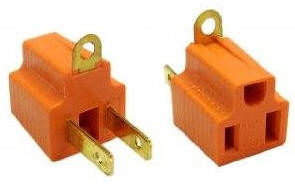How to Convert 2 prong to 3 prong Receptacle
Modern building codes require three-prong receptacles while some older homes still have the two-prong variety. What options do you have for converting the 2 prong receptacles to 3 prongs? Two-prong receptacles have no ground and the wiring that feeds these receptacles typically does not carry the ground wire. Modern NEC code does not permit installing two-prong receptacles in new or remodel construction due to the inherent safety risk associated with not grounding appliances that you plug in.
3 Prong to 2 prong grounding converter

These devices are designed to allow you to plug a three prong device into a two prong outlet. You'll notice the grounding lug with a circle in the middle that most people fail to use. This is designed to connect a grounding wire to and should be used to provide a "real" ground to the 3 prong appliance or device you are plugging in. This is very important if you are plugging in a surge protector for a PC or home audio equipment. A surge protector is useless without a ground since the protecting diodes in the surge protector route the excess energy from a surge or lightning strike to ground. If the ground is missing, that energy spike goes straight to your equipment.
Methods for converting 2 prong to 3 prong outlets
1. Run a ground conductor from the receptacle box to the main electrical panel (Ideal case)
2. Install a GFCI receptacle and leave the ground terminal disconnected in the junction box. The GFCI will serve as the safety protection if for some reason there is a fault in the device you are plugging in, you will be safe. This does not fix the problem of not having a real ground. In some applications, like a surge protector, this is a bad option.
3. Connect a ground wire from the junction box to a nearby metal cold water pipe that is continuous all to way to the ground. In older homes, water pipes were often plumbed with copper rather than the plastic PEX tubing used today. Copper pipes can serve as an excellent ground but you must be sure they are tied to ground on the other end. You can check grounds by using an ohm meter and a long wire back to your breaker panel ground or other sure ground connections at your home.
4. If wiring is done through metal conduit and this conduit is continuous back to the breaker panel you can connect the ground in your receptacle box to the metal receptacle box itself. This is not highly recommended in the electrical community but it is better than no ground at all. If you are in this boat, you should probably consider pulling new wire through the conduit that includes the hot wire, neutral, and ground and your electrical wiring will be fully up to code.
